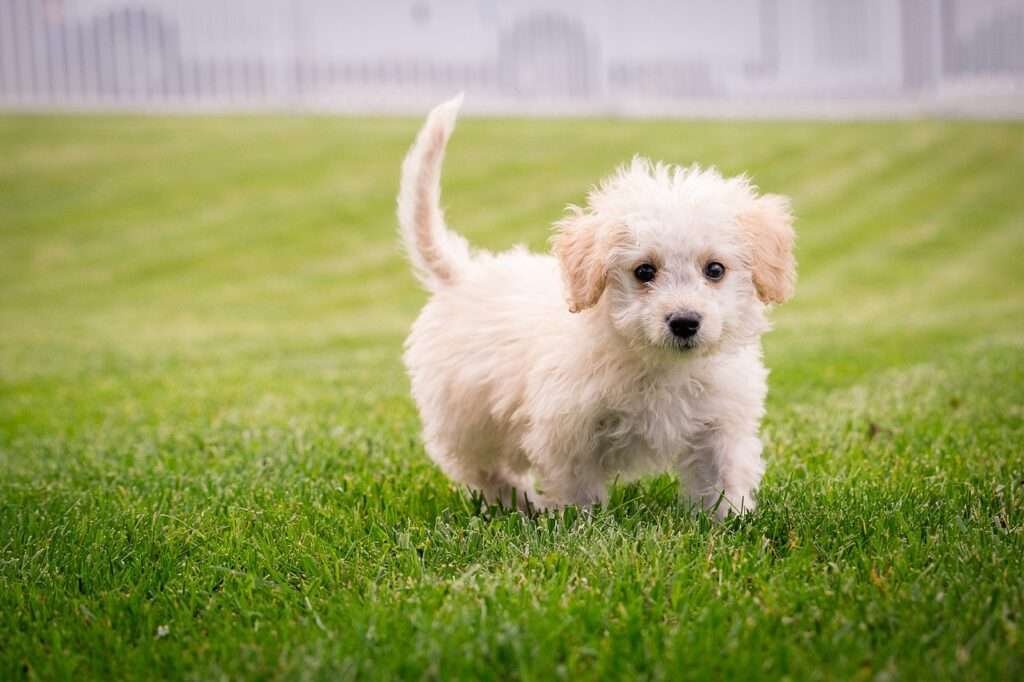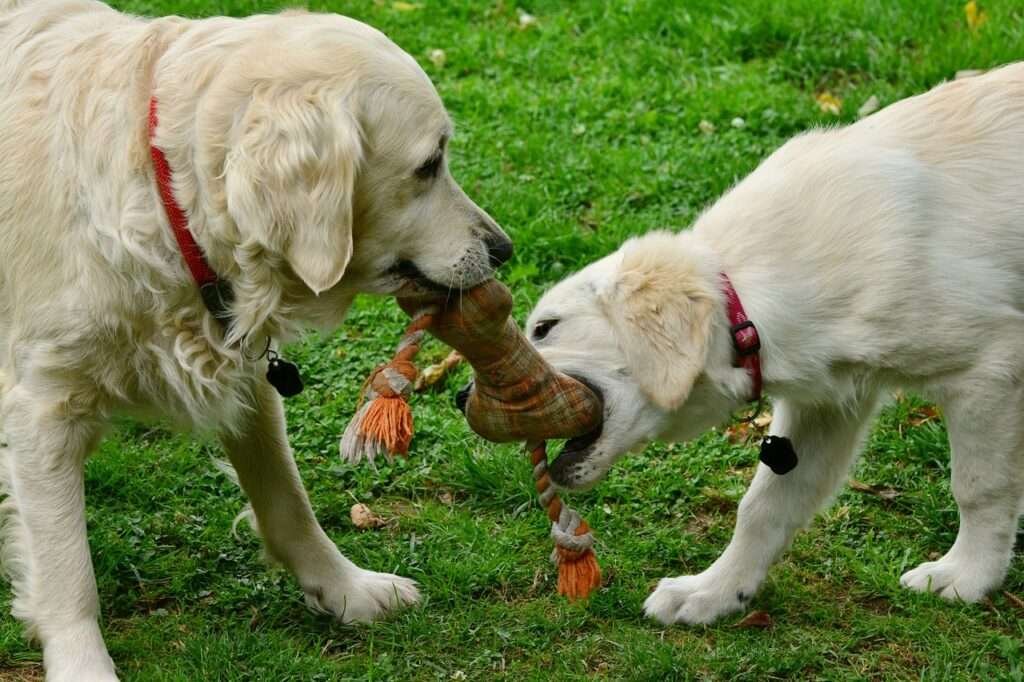As a dog owner, you might have noticed that your dog is biting or chasing his tail Often. I’m sorry to hear about this. I’ve been there, and it’s pretty gross. While some may seem cute or amusing at first, frequent tail biting can be a sign that something is not quite right. If you’re wondering why your dog is biting his tail, there are a few possibilities ranging from harmless behaviors to more serious health concerns. Understanding these reasons can help you figure out the best way to help your pet.

Table of Contents
ToggleCommon Reasons Why Dogs Bite Their Tails
1. Boredom or Anxiety
The first thing to look at is whether or not he’s in pain. If he has an injury or something causing him pain, he might be biting his tail to relieve that pain. If your dog is healthy and his tail doesn’t seem injured, it could be that he’s nervous or anxious. Dogs are highly active and intelligent animals, and if they don’t have enough mental and physical stimulation, they may resort to behaviors like tail chasing as a way to entertain themselves. Dogs, like people, can also get bored or anxious. When they don’t have enough mental or physical stimulation, they may start to exhibit repetitive behaviors like tail biting. If your dog is left alone for long periods or doesn’t get enough exercise, he might chase his tail as a way to entertain himself or relieve stress.
Solution:
Make sure your dog gets plenty of exercise and playtime. Interactive toys, puzzle feeders, and regular walks can help keep your dog’s mind and body active. If you think anxiety is the issue, consider calming products like pheromone diffusers or consult your vet about other calming techniques. If it’s just a nervous habit, however, sometimes the best thing to do is just let them go at it until they get tired of it. Some dogs will stop on their own after a while if they’re just trying to relieve some tension.
2. Fleas or Ticks
Parasites such as worms, fleas, and ticks in that area can cause extreme discomfort, prompting the dog to seek relief by biting its tail. Every animal carries these pests but don’t notice them as the fur of dogs are very denced and these pests are common and can easily be picked up during walks or from other animals. Parasites Besides fleas and ticks, other parasites like mites can also cause tail biting. Mites can lead to conditions such as mange, which causes severe itching and discomfort.
Solution:
Regularly check your dog for fleas and ticks. Use a flea comb to inspect your dog’s fur and look for signs of these pests. Flea and tick prevention products, such as topical treatments or collars, can help keep these pests away from your dog. If you notice excessive scratching or hair loss, take your dog to the vet and discuss the issue.
3. Allergies
Dogs can have allergies just like humans. They might be allergic to certain foods, pollen, dust, or even the shampoo you use to bathe them. Allergies can cause itching and irritation all over their bodies, including their tails.
Solution:
If you suspect your dog has allergies, These conditions may require treatment from a veterinarian.. They can help identify the cause of the allergies and suggest appropriate treatments. Changing your dog’s diet, using hypoallergenic products, or giving your dog allergy medication might be necessary.
4. Skin Infections or Irritations
Skin infections, hot spots, or irritations can cause a dog to bite his tail. Bacterial or fungal infections, as well as injuries or sores, can lead to discomfort and itching.
Solution:
Regular grooming and inspection of your dog’s skin can help you spot any problems early. If you notice redness, swelling, or sores, take your dog to the vet. They can prescribe medications to treat infections or recommend topical treatments to soothe irritated skin.
5. Anal Gland Issues
One of the main reason a dog may resort to biting at the base of its tail until it bleeds could be an impacted anal gland. The most apparent indication of this issue is scooting, where the dog sits and drags its bottom across the floor or any other surface. Dogs have two small glands located near their anus, called anal glands. These glands can become impacted or infected, causing discomfort and prompting dogs to bite or lick their tails and rear ends.
Solution:
If your dog is frequently licking or biting his rear end, it could be due to anal gland problems. Your vet can express the glands to relieve the pressure or treat any infections if necessary.
6. Behavioral Issues
If you’ve recently adopted a puppy and notice them chasing their tail, it’s likely just part of their natural exploration process as they familiarize themselves with their bodies. On the other hand, Sometimes tail biting can become a compulsive behavior, similar to how people might develop habits like nail-biting. Dogs can also exhibit compulsive behaviors such as tail chasing. This can be due to a lack of stimulation, anxiety, or other underlying behavioral issues.
Solution:
It’s crucial to remain calm, as this behavior is normal in puppies. For older dogs behavioral problems can be challenging to address. Providing plenty of mental and physical stimulation can help. In more severe cases, working with a professional dog trainer or a veterinary behaviorist may be necessary to modify your dog’s behavior.
When to See the Vet
If a dog consistently chases and bites its tail without any apparent cause, it’s essential to take them to a vet for a thorough diagnosis. The vet can rule out any underlying health problems or provide appropriate treatment. Here are some signs that indicate it’s time to see the vet:
Persistent biting or chewing: If your dog is constantly biting his tail, it could be a sign of an underlying problem that needs veterinary attention.
Redness or swelling: If the tail appears red, swollen, or irritated, it’s essential to get it checked out.
Hair loss or sores: Any signs of hair loss, open sores, or wounds on the tail require veterinary care.
Changes in behavior: If your dog’s behavior changes suddenly, such as becoming more aggressive or withdrawn, it’s important to consult your vet.

How to Preventing Tail Biting
Prevention is always better than cure. Here are some tips to help prevent your dog from developing a tail-biting habit:
Regular Grooming and Check-ups
Practicing proper hygiene and regular grooming routines can prevent matted hair and potential infections. Keep your dog clean and groomed. Regular baths, brushing, and inspections can help you spot any problems early. Regular vet check-ups ensure that any health issues are addressed promptly.
Flea and Tick Prevention
Administering monthly flea and tick preventatives helps ward off external parasites. Regular deworming is essential to prevent internal parasites, with puppies requiring deworming at 2, 4, 6, 8, and 12 weeks of age, while adult dogs should undergo deworming thrice a year. Use flea and tick prevention products as recommended by your vet. Regularly check your dog for signs of these pests, especially after walks or playtime outdoors.
Proper Nutrition
Maintaining a diet high in fiber can aid in preventing loose stools. Firmer stools exert more pressure on the glands, facilitating proper secretion. It is essential for your dog’s overall health. Make sure your dog is getting the right nutrients to keep his skin and coat healthy. If your dog has food allergies, work with your vet to find an appropriate diet.
Mental and Physical Stimulation
Provide plenty of exercise and mental stimulation. Regular walks, playtime, and interactive toys can help keep your dog happy and prevent boredom-related behaviors.
Stress and Anxiety Management
If your dog is prone to anxiety, create a calm and secure environment. Use calming products like pheromone diffusers, and consider training techniques that promote relaxation. In severe cases, your vet may recommend medications or refer you to a behaviorist.
Avoid Accidents
Supervision is crucial when dogs are around small children to prevent accidental tail pulling or stepping, which could cause the dog to bite. Avoid leaving them unsupervised to ensure the safety of both the dog and the child.
tail biting in dogs can be caused by a variety of factors, including discomfort, boredom, or compulsive behavior . By addressing the underlying cause and providing your dog with appropriate stimulation, you can help prevent this behavior and ensure that your furry friend stays happy and healthy.
Remember, your dog relies on you to keep him healthy and happy. Paying attention to his behavior and addressing any issues promptly can help ensure he leads a comfortable and fulfilling life.



